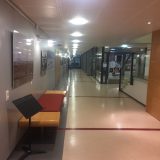Jinan University, Guanzhou, China
I completed my teacher practice at Jinan University in a city of Guangzhou in the province of Guangdong in south of China in October-November 2015.
China’s influence is increasing everywhere in the world and it is visible nowhere more than in higher education institutions. In some top American universities already one third of students have Chinese background and for example in Aalto University where I work we have nowadays Chinese students in almost every course. Yanhong’s earlier post in this blog described very well the contrast between the classic Chinese and modern western approaches to teaching and learning. Thus, I wanted to explore how I could implement more “learner centric” methods for the Asian students and Jinan University was keen to learn more “western methods”.
Jinan University (JNU) is a public research and comprehensive university and it is one of the oldest universities established on mainland China tracing back to the Qing dynasty (1644–1911). Its mission is to spread Chinese learning and culture from North to South, and from China overseas. Jinan University was the first university in China to recruit foreign students, and is currently the Chinese university with the largest number of international students. Its International School provides undergraduate programs taught fully in English in nine subjects varying from pharmacy to accounting.
My teaching practice consisted of 18 hours of teaching in a Public Finance course and observing 33 hours of teaching in other courses. My observation are very similar to what also Yanhong observed: teaching is mostly lecturing and very teacher centric. However, this wouldn’t necessarily need to be case. I observed also lot of pending demand for more student-centric and interactive methods both from students and teachers. In the feedback forms that I collected from my own lectures students clearly expressed their satisfaction for the methods I used. Similarly almost every teacher I spoke was worried by the lack of interaction in the class. My own experience confirmed what also Yanhong pointed, students are actually ready for more interaction. The lack of interaction is probably more just an old habit and due to the lack of proper pedagogical training for teachers. That’s something where we have lot to give to China. Go east, young teachers!
I was teaching the Public Finance course for two different classes. Second year accounting and fourth year finance students. Three 3h sessions for both groups. I.e. I got an opportunity to experiment teaching the same content twice. Topics that I taught were Health Care, Pension, and Income Redistribution systems. What could be more suitable than have a teacher from a Nordic welfare country to talk about those topics! At least some balanced view to the American book and mostly Chinese context. I decided to apply three different kind of teaching methods: first week was traditional lecturing supported with some computer-facilitated (Socrative) interaction, second week was group work or “participants teach”, in the third week we had debates in the class.
The lessons went much better than I expected. Of course the level of interaction was not as high as it might have been somewhere else, but it improved all the time. Naturally, there were some challenges when the exercises we did were new to many, but these students were keen to learn and the course feedback was overwhelmingly positive. In general I am always impressed how hard-working and smart Chinese students are. It is very rewarding experience for a teacher to teach such talented students and students appreciated really lot what I did with them.
Guangzhou itself is China’s 3rd biggest city – its metropolitan area has some 25 million people. It and the surrounding Guangdong province have always been China’s gateway to outside world so it is perhaps bit more open-minded for new ideas than other provinces. Guangzhou is developing and getting rich extremely fast. For those who want to feel the buzz of fortunes (and history) being made around you, it is a must-visit place.
Jinan University is probably among the easiest place to land in China as non-Chinese teacher. Reception was very warm, all people around were very helpful and friendly and students were keen to learn from visiting teachers. Jinan University also expressed that they would be interested to have teacher trainees from us also in the future. Please contact our international coordinator if you are interested in. I can highly recommend it.
Thank you Jinan University for this opportunity!
Timo M. Partanen













